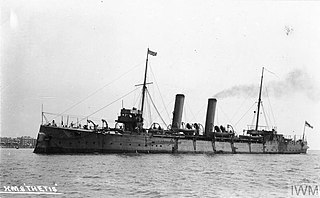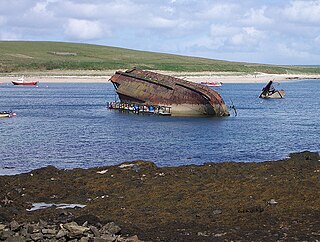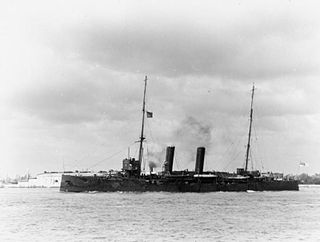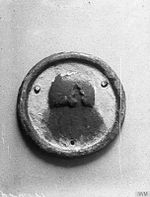Eight ships of the Royal Navy have been named HMS Intrepid:

HMS Thetis was an Apollo-class 2nd class protected cruiser of the Royal Navy, launched on 13 December 1890. Her first significant mission was service in the Bering Sea Patrol with American warships in a combined effort to suppress poaching in the Bering Sea.

A blockship is a ship deliberately sunk to prevent a river, channel, or canal from being used. It may either be sunk by a navy defending the waterway to prevent the ingress of attacking enemy forces, as in the case of HMS Hood at Portland Harbour in 1914; or it may be brought by enemy raiders and used to prevent the waterway from being used by the defending forces, as in the case of the three old cruisers HMS Thetis, Iphigenia and Intrepid scuttled during the Zeebrugge raid in 1918 to prevent the port from being used by the German navy.

HMS Juno was an Eclipse-class protected cruiser built for the Royal Navy in the mid-1890s.

The Zeebrugge Raid on 23 April 1918, was an attempt by the Royal Navy to block the Belgian port of Bruges-Zeebrugge. The British intended to sink obsolete ships in the canal entrance, to prevent German vessels from leaving port. The port was used by the Imperial German Navy as a base for U-boats and light shipping, which were a threat to Allied control of the English Channel and southern North Sea. Several attempts to close the Flanders ports by bombardment failed and Operation Hush, a 1917 plan to advance up the coast, proved abortive. As ship losses to U-boats increased, finding a way to close the ports became urgent and the Admiralty became more willing to consider a raid.

HMS Andromache was an Apollo-class protected cruiser of the Royal Navy. William Henry White designed her, and she was built at Chatham Dockyard and launched on 14 August 1890. The total cost of construction was £186,234.

HMS Amphitrite was a ship of the Diadem-class of protected cruisers in the Royal Navy, which served in the First World War.

HMS Ariadne was a Diadem-class protected cruiser of the Royal Navy, which was launched in 1898, In March 1913, she was converted to a stokers' training ship and in 1917 was converted to a minelayer and assigned to the Nore Command. She was torpedoed and sunk off Beachy Head by the German submarine UC-65 on 26 July 1917.

HMS Vindictive was a British Arrogant-class cruiser built at Chatham Dockyard. She was launched on 9 December 1897 and completed in 1899. The vessel participated in the Zeebrugge Raid.

HMS Brilliant was an Apollo-class cruiser of the British Royal Navy which served from 1893 to 1918 in various colonial posts and off the British Isles as a hastily converted minelayer during the First World War.

HMS Sirius was an Apollo-class cruiser of the British Royal Navy which served from 1892 to 1918 in various colonial posts such as the South and West African coastlines and off the British Isles as a hastily converted minelayer during the First World War.

HMS Sappho was an Apollo-class cruiser of the British Royal Navy which served from 1892 to 1918 in various colonial posts.
HMS Myrmidon was one of two Myrmidon-class destroyers which served with the Royal Navy.
Four ships of the Royal Navy have borne the name HMS Iphigenia, after Iphigenia, a figure in Greek mythology:

The Arrogant-class cruiser was a class of four protected cruisers built for the British Royal Navy at the end of the 1890s. One ship, HMS Gladiator, was lost following a collision with a merchant ship in 1908, while HMS Vindictive saw active service in the First World War, taking part in the Zeebrugge Raid in April 1918 before being sunk as a blockship during the Second Ostend Raid in May 1918.

HMS Latona was an Apollo-class protected cruiser of the Royal Navy which served from 1890 to 1920.
HMS Murray was a Royal Navy Admiralty M-class destroyer. Ordered before the outbreak of war, she was therefore the first of her class to enter operation during the early months of the First World War. She was also the first vessel of the Royal Navy to carry the name HMS Murray.

HMS Iphigenia was an Apollo-class protected cruiser of the Royal Navy built on the River Clyde and launched in 1891. She was subsequently converted as a minelayer in the latter half of her career and ultimately sunk as a blockship during the Zeebrugge Raid on 23 April 1918.

HMS Speedy was a Alarm-class torpedo gunboat of the British Royal Navy. She was built by Thornycroft from 1892–1894. She was converted to a minesweeper in 1908–1909 and continued these duties during the First World War. Speedy was sunk by a German mine on 3 September 1914.

HMS Landrail was a Laforey-class destroyer of the British Royal Navy. The Laforey class was the class of destroyers ordered under the Royal Navy's 1912–1913 construction programme, which were armed with three 4-inch (102 mm) guns and four torpedo tubes and were capable of 29 knots. The ship, which was originally to be named Hotspur but was renamed before launch, was built by the Scottish shipbuilder Yarrow between 1912 and 1914,



















